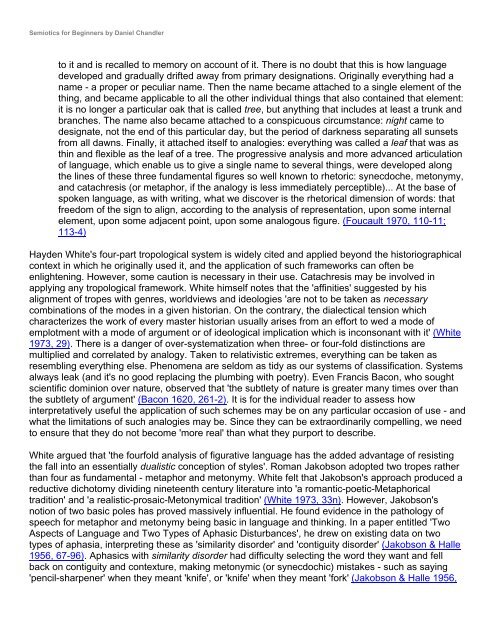Semiotics for Beginners by Daniel Chandler
Semiotics for Beginners by Daniel Chandler
Semiotics for Beginners by Daniel Chandler
Create successful ePaper yourself
Turn your PDF publications into a flip-book with our unique Google optimized e-Paper software.
<strong>Semiotics</strong> <strong>for</strong> <strong>Beginners</strong> <strong>by</strong> <strong>Daniel</strong> <strong>Chandler</strong><br />
to it and is recalled to memory on account of it. There is no doubt that this is how language<br />
developed and gradually drifted away from primary designations. Originally everything had a<br />
name - a proper or peculiar name. Then the name became attached to a single element of the<br />
thing, and became applicable to all the other individual things that also contained that element:<br />
it is no longer a particular oak that is called tree, but anything that includes at least a trunk and<br />
branches. The name also became attached to a conspicuous circumstance: night came to<br />
designate, not the end of this particular day, but the period of darkness separating all sunsets<br />
from all dawns. Finally, it attached itself to analogies: everything was called a leaf that was as<br />
thin and flexible as the leaf of a tree. The progressive analysis and more advanced articulation<br />
of language, which enable us to give a single name to several things, were developed along<br />
the lines of these three fundamental figures so well known to rhetoric: synecdoche, metonymy,<br />
and catachresis (or metaphor, if the analogy is less immediately perceptible)... At the base of<br />
spoken language, as with writing, what we discover is the rhetorical dimension of words: that<br />
freedom of the sign to align, according to the analysis of representation, upon some internal<br />
element, upon some adjacent point, upon some analogous figure. (Foucault 1970, 110-11;<br />
113-4)<br />
Hayden White's four-part tropological system is widely cited and applied beyond the historiographical<br />
context in which he originally used it, and the application of such frameworks can often be<br />
enlightening. However, some caution is necessary in their use. Catachresis may be involved in<br />
applying any tropological framework. White himself notes that the 'affinities' suggested <strong>by</strong> his<br />
alignment of tropes with genres, worldviews and ideologies 'are not to be taken as necessary<br />
combinations of the modes in a given historian. On the contrary, the dialectical tension which<br />
characterizes the work of every master historian usually arises from an ef<strong>for</strong>t to wed a mode of<br />
emplotment with a mode of argument or of ideological implication which is inconsonant with it' (White<br />
1973, 29). There is a danger of over-systematization when three- or four-fold distinctions are<br />
multiplied and correlated <strong>by</strong> analogy. Taken to relativistic extremes, everything can be taken as<br />
resembling everything else. Phenomena are seldom as tidy as our systems of classification. Systems<br />
always leak (and it's no good replacing the plumbing with poetry). Even Francis Bacon, who sought<br />
scientific dominion over nature, observed that 'the subtlety of nature is greater many times over than<br />
the subtlety of argument' (Bacon 1620, 261-2). It is <strong>for</strong> the individual reader to assess how<br />
interpretatively useful the application of such schemes may be on any particular occasion of use - and<br />
what the limitations of such analogies may be. Since they can be extraordinarily compelling, we need<br />
to ensure that they do not become 'more real' than what they purport to describe.<br />
White argued that 'the fourfold analysis of figurative language has the added advantage of resisting<br />
the fall into an essentially dualistic conception of styles'. Roman Jakobson adopted two tropes rather<br />
than four as fundamental - metaphor and metonymy. White felt that Jakobson's approach produced a<br />
reductive dichotomy dividing nineteenth century literature into 'a romantic-poetic-Metaphorical<br />
tradition' and 'a realistic-prosaic-Metonymical tradition' (White 1973, 33n). However, Jakobson's<br />
notion of two basic poles has proved massively influential. He found evidence in the pathology of<br />
speech <strong>for</strong> metaphor and metonymy being basic in language and thinking. In a paper entitled 'Two<br />
Aspects of Language and Two Types of Aphasic Disturbances', he drew on existing data on two<br />
types of aphasia, interpreting these as 'similarity disorder' and 'contiguity disorder' (Jakobson & Halle<br />
1956, 67-96). Aphasics with similarity disorder had difficulty selecting the word they want and fell<br />
back on contiguity and contexture, making metonymic (or synecdochic) mistakes - such as saying<br />
'pencil-sharpener' when they meant 'knife', or 'knife' when they meant '<strong>for</strong>k' (Jakobson & Halle 1956,




